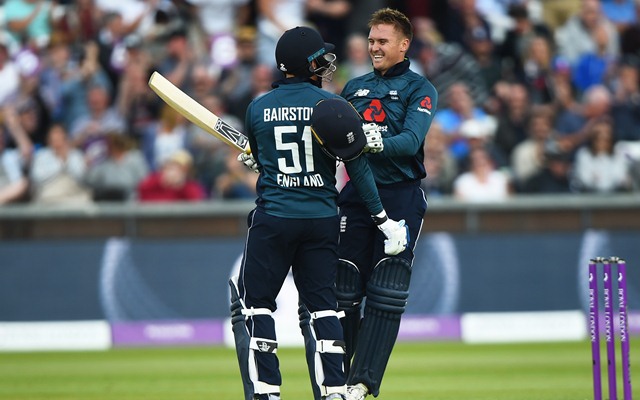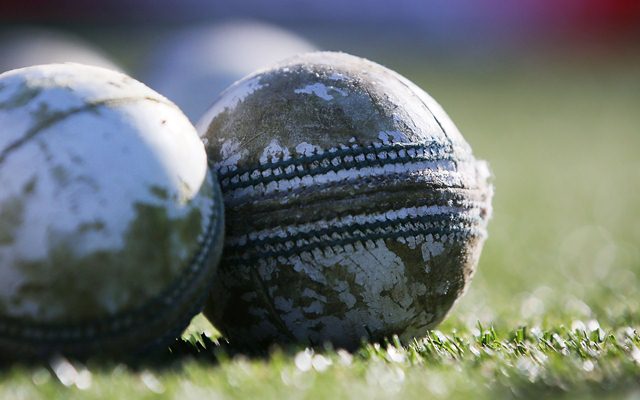Two new balls in ODI cricket - boon or bane?
In what was widely termed as a "mini-revolution", the rule of using two new balls from either end in alternate overs in ODI cricket was introduced by the ICC in late 2011.
2 Min Read


41 fours and 21 sixes in a single inning of an ODI match is what the spectators were in for on June 19, 2018, when Australia and England faced off against each other at Trent Bridge, Nottingham. In what turned out to be the highest ODI team total in the history of the game, England registered 481 runs against the hapless Aussies and ended up winning by a whopping margin of 242 runs.
While this run feast may seem delectable at the outset, in reality, it’s a Pandora’s box full of not-so-pleasant consequences. So much so that it prompted cricketers of as much calibre as Sachin Tendulkar and Waqar Younis to raise questions about the repercussions of having two new balls in ODI cricket. So, is having two new balls in the limited-overs white-ball cricket a healthy approach or not?
Introduction of the two new ball rule in ODI cricket
In what was widely termed as a “mini-revolution” back in the day, the rule of using two new balls from either end in alternate overs in ODI cricket was introduced by the International Cricket Council (ICC) in late 2011. The move was devised to inject more life into white-ball cricket, giving the batsmen an edge over the bowlers and thereby, opening up the floodgates for high-scoring matches.
What followed was an increasingly aggressive onslaught by the batsmen devoid of any major speed breakers to check their progress. Bearing testimony to the alarming consequences is the fact that 6 of the 10 highest ODI scores in the history of the sport have been scored post the declaration of the “two new balls” rule. Although the rule has been in effect for the last 7 years, it’s only recently that experts have started raising concerns over its possible detrimental long-term effects on the game.
On the upside
The original intent with which the rule was introduced was a calculated one. It had been almost 6 years that the first international T20 match had ever been played (New Zealand vs Australia in 2005) and the audience wanted to see more boundaries and sixes instead of meagre scores. Hence, the obvious trick at hand was to shorten the boundaries, flatten the pitches and introduce a rule that’d enable the batsmen to hit the ball as quick and hard as it was delivered to them all throughout the innings.
Now what this has successfully done is to procure some of the best innings in the world with the bat. Be it Rohit Sharma‘s scintillating double century against Sri Lanka at the Eden Gardens or Martin Guptill’s unbeaten double ton in 2015, the display of batting has been monumental post this rule. Not only has this induced more life and excitement into the game, but has also prevented the turnout at stadiums from dwindling as more and more people have come out regularly to the grounds to see the boundaries raining.
The downside
As the old saying goes: “too many cooks spoil the broth.” It won’t be too wrong to say the same about having new balls in a single ODI inning. A sport that was conceived as a contest between the bat and the ball is increasingly becoming a myopic version of its original grandeur, with only the bat reigning supreme. The age-old techniques of swing and reverse swing have died a humiliating death in the limited-overs white ball cricket because there simply isn’t time enough for them to come into play.
As Harsha Bhogle rightly pointed out in a recent Cricbuzz video, the white Kookaburra ball, by default, doesn’t have much on offer, considering it doesn’t move and the seam rarely lasts for even half an innings. The only bit of action that it did use to provide was the swing and the reverse swing, but it needs to be enough overs old to be able to produce those tricks. Earlier, the ball that used to be bowled for 50 overs straight gets only 25 overs from one end on today’s date.
Not only does this make the game uni-dimensional but essentially, robs the bowler of all that’s in his hands, especially the pacer. The poor fast bowler can’t bowl fast or he’ll be hit out of the ground equally quickly, he cannot bowl slower at the risk of the ball not gripping off the turf and being hit for a biggie anyway. With the pacer not receiving any movement in the air because the ball isn’t seasoned enough and the seam is virtually non-existent at the slightest of wear and tear, the most ferocious breed of international bowlers are practically being rendered defunct day by day.
Seems like the greats of the game agree
Soon after England versus Australia ODI, tweets poured in and they weren’t all congratulatory ones. Stalwarts of the game like Sachin Tendulkar, Bradd Hogg and Waqar Younis expressed their concern over the impending doom on the future of the game as it’s no longer giving the bowlers a fair chance. Mike Atherton penned a beautiful yet alarmingly premonition-like piece on how 481 was great, but it’s about time we draw a line.
Former Indian skipper Sourav Ganguly echoed the same opinion as he wrote, “Too see almost 500 runs scored in 50 overs in England is scaring me ..about the health of the game and where it’s going.. Australian bowling getting treated this way whatever the conditions may be is not acceptable..A country of lillee, thompson, benaud.”
Having 2 new balls in one day cricket is a perfect recipe for disaster as each ball is not given the time to get old enough to reverse. We haven’t seen reverse swing, an integral part of the death overs, for a long time. #ENGvsAUS
— Sachin Tendulkar (@sachin_rt) June 21, 2018
Reason why we don’t produce many attacking fast bowlers..They all very defensive in their approach…always looking for change ups..totally agree with you @sachin_rt reverse swing is almost vanished.. #SAD https://t.co/hPHoMXujcr
— Waqar Younis (@waqyounis99) June 21, 2018
481 is great but now it is time to end two-ball folly @sachin_rt @StuartBroad8https://t.co/O5FOtxnTbU
— Mike atherton (@Athersmike) June 22, 2018
Current implications
If one were to examine closely, it’d be surprising to find how many youngsters today are choosing to learn spin bowling against their natural instinct. Pakistan – a country that was known to be a gold mine of pacers, is supposedly at a dearth of quality fast bowlers. This is because of the basic nature of the game in the current scenario where both pace, barring the odd success stories of men like Andrew Tye and Hasan Ali, as well as finger spin have been almost nullified. Bhogle sums it up nicely as he says, “pace still works, but it’s no longer a deterrent.”
It’s only the wrist spinners that still possess some upper hand over the batsmen as they’re able to garner movement in the trajectory of the ball. Therein lies the looming problem of the game getting reduced to bat versus bat instead of being the classic, old bat versus ball. If this trend was to continue, scores would keep piling up day by day to a place with no limits. Remember this: the England batsmen left the field with dejected faces after posting 481 runs on the board. Why? Because they were disappointed to have not scored a 500! Let that sink in.
Possible solutions

The 50-over format of cricket desperately needs a revamp to bring back some of the sanity. That the ICC would do away with the “two new balls” rule and revert to the old rules is wishful thinking, no matter how healthy it might be for the future of the game. Some have also rightly pointed out at how this concern is being voiced a few years too late. Once you’ve gotten a cricket fan addicted to 400+ scores and frequent double centuries, will they be satisfied with team scores of 150-200 ever again?
One plausible solution might be to replace the good, old Kookaburra with its exciting younger sibling, the Duke’s white ball. The seam of the latter is way more prominent and long-lasting, enough to trouble the batsmen, induce swing and bring some of the zing back into the game. The small boundaries need to be adjusted and the field restrictions in the powerplay overs need to be revised to take the burden off the bowlers, even if slightly.
With the onset of technology, the game is vastly tilted in the favour of the batsman today. Be it the protective gear, the better sight screens or the masterfully crafted bats, the batsmen have had their jobs made easier, even if marginally. It’s high time that the bowlers were rescued from their abject misery and are brought back into the game where the ball challenges the bat in a way that’d make both Shane Warne and Sachin Tendulkar proud of the game called cricket!
Download Our App